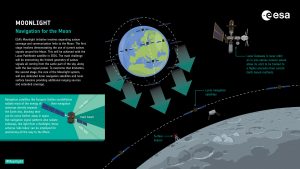ESA appoints Surrey Satellite to lead Moonlight telecoms initiative

Two consortia have been selected to create the necessary commercially viable constellation of lunar satellites, designed to enable sustainable space exploration.
Surrey Satellite Technology will lead the first consortium, both through its lunar services brand SSTL Lunar and as the satellite manufacturer.
The consortium also includes: satellite manufacturer Airbus; satellite network providers SES, based in Luxembourg, and Kongsberg Satellite Services, based in Norway; the Goonhilly Earth Station in the UK; and British satellite navigation company GMV-NSL.
The second consortium will be lead by Telespazio, working with: satellite manufacturer Thales Alenia Space; satellite operator Inmarsat, based in the UK; Canadian space technology company MDA; Telespazio’s subsidiary in Germany and OHB Systems; Spanish satellite operator Hispasat; and the Italian Aerospace Logistics Technology Engineering Company (ALTEC), aerospace engineering company Argotec, Nanoracks Europe, the Politecnico Milano and the Università commerciale Luigi Bocconi.
Moonlight
ESA explains the thinking behind the Moonlight initiative:
“A reliable and dedicated lunar communications and navigation service would allow missions to land wherever they wanted. Radio astronomers could set up observatories on the far side of the Moon. Rovers could trundle over the lunar surface more speedily. It could even enable the tele-operation of rovers and other equipment from Earth.”
“Using a shared telecommunications and navigation service would reduce the design complexity of future individual missions and make them lighter, freeing space for more scientific instruments or other cargo, making each individual mission more cost-efficient.”
The agency highlights that dozens of international, institutional and commercial teams are sending missions to the Moon that envisage a permanent lunar presence. These will become regular trips, rather than one-off expeditions, it is anticipating.
A reliable and dedicated lunar communications and navigation service would allow missions to land wherever they wanted. For example, it says, radio astronomers could set up observatories on the far side of the Moon. Or rovers could travel over the lunar surface more speedily. It could even enable, it suggests, the tele-operation of rovers and other equipment from Earth.
The Moonlight initiative builds on both the ESPRIT communications module and the Lunar Pathfinder.
You can read more on the European Space Agency’s website.